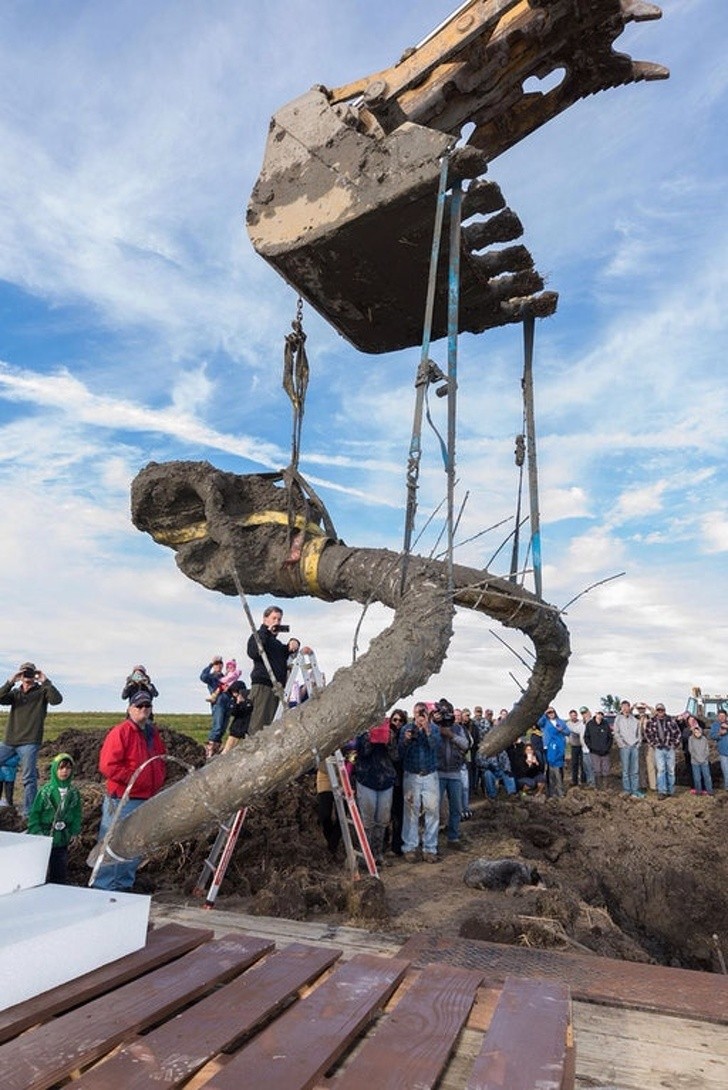Archaeologists dedicate their lives to unravel the material history of our world. However, some discoveries are made by common people who don’t even realize what happened. Imagine finding an entrance to ancient catacombs in your backyard — how cool is that?
We have made a list of such accidental discoveries, some of which have had a really profound impact on history. Brace yourselves for some digging!
So scroll down to look at this list of Astonishing Archaeological Findings That Were Found by a Pure Accident.
James Bristle and his other farmer friend found a Wooly Mammoth

James Bristle and his other farmer friend were digging in their soybean field like usual when they realized they hit something. It was none other than the discovery of a 15,000-year-old giant woolly mammoth. The incident took place in 2015 in southern Michigan where a skull and two tusks were found along with the vertebrae.
a laborer named Adrien Quinquin dug up Childeric’s treasure instead of dirt

This is a signet ring that is a part of Childeric’s treasure. It’s a heavy gold ring 27mm (one inch) in diameter, which is an indication that Childeric had big fat fingers. Back in 1653, a laborer named Adrien Quinquin was digging on the land of the church of Saint-Brice in Tournai when, instead of dirt, he found gold coins. Apart from CHILDERICI REGIS, the ring in the picture, he also found a hundred more coins, swords made of gold and garnet, horse fittings and buckles, a gold torch, a gold bull’s head, and 300 gold bees.
The Grauballe Man: a unique mummy

On a normal peat bog where workmen were digging for peat, one of the workers suddenly realized his spade hadn’t touched the peat but something else. It ended up being the mummy of the Grauballe Man, and his hair and fingernails were intact even after centuries. This mummy was the first to be fully preserved as a whole body.
It was dated back to the late 3rd century BC. In 1955, the body was moved to the Moesgaard Museum near Aarhus for public display. Also, his fingers were still in place so scientists were able to take his fingerprints.
Two German tourists hikers bumped into Otzi the Iceman

Two German tourists were hiking at the mountain pass of Hauslabjoch and Tisenjoch when they made the discovery of a lifetime. It was Europe’s oldest known natural human mummy which they first thought was the deceased body of a mountaineer. The mummy was found in September 1991 in the Ötztal Alps, which gave it the nickname Otzi.
The discovery was significant because it cast a light on the Chalcolithic (Copper Age) Europeans. Another interesting story involving Otzi is that a few people involved in his discovery have died under mysterious circumstances hinting towards Otzi being cursed.
The Derinkuyu Underground City: an incredible network of tunnels

It was in 1963 when a man discovered a mysterious wall structure behind one of the rooms in his house. As archaeologists were called for further investigation, a whole passage of tunnels was found which is now popularly known as The Derinkuyu Underground City.
It’s believed that the city was built in the Byzantine era to protect the inhabitants from Muslim-Arabs during the Arab—Byzantine wars. These tunnels were largely used by Christian natives and they were said to have given shelter and provided food saving almost 20,000 people.
The underground city is located in the Derinkuyu district of the Nevşehir Province in Turkey and has been open to the general public since 1969.
The mesmerizing Lascaux cave paintings

18-year-old Marcel Ravidat happened to discover the stunning entrance to Lascaux. Taken by surprise, he decided to return to the site with three friends and they saw that the walls of the caves were full of depictions of animals. The cave was opened to the general public on July 14, 1948. However, due to air pollution, dust, and carbon dioxide exposure the paintings started losing their original form. It was then decided to close the attraction to tourists. These paintings largely depict the Upper Paleolithic era.
Jehoash Inscription

This discovery of the Jehoash Inscription was surrounded by several controversies when it was first discovered on a construction site or Muslim cemetery near the Temple Mount of Jerusalem. The controversy is whether the inscription is authentic or is a modern-day forgery. The Israel Antiquities Authority had raised doubts over its authenticity.
Horse and chariot pits in Zhou Dynasty tomb

https://news.nationalgeographic.com
Scientists and archaeologists believe that this burial pit belonged to one of the noble families of the Zheng state (806–375 BC). The dig was conducted in central China, in the city of Xinzheng, where dozens of chariots and almost 100 skeletons of horses were found that are 2400 years old. One of the highlights of this excavation was a chariot that was 2.4m long and around 1.7m wide and adorned with bronze and bone.
Related Content
These unique shots which can only be captured once in a lifetime
This post was created with our nice and easy submission form. Create your post!






Comments
Loading…